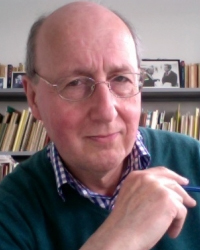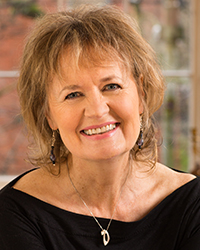 Following on from Emily Howard’s Torus, two further Proms premières have continued the relationship with the orchestral concerto archetype: Bayan Northcott’s Concerto for Orchestra and Thomas Larcher‘s Symphony No. 2, which began life as one but developed in a different direction. Larcher’s symphony was commissioned to commemorate the 200th anniversary of the Oesterreichische Nationalbank, but far from being celebratory, the piece, dourly subtitled ‘Kenotaph‘, is bound up in thoughts and feelings instilled by the ongoing refugee crisis. Although not programmatic, Larcher has used the symphony to compose an ‘outcry’ at the sense of helplessness he felt.
Following on from Emily Howard’s Torus, two further Proms premières have continued the relationship with the orchestral concerto archetype: Bayan Northcott’s Concerto for Orchestra and Thomas Larcher‘s Symphony No. 2, which began life as one but developed in a different direction. Larcher’s symphony was commissioned to commemorate the 200th anniversary of the Oesterreichische Nationalbank, but far from being celebratory, the piece, dourly subtitled ‘Kenotaph‘, is bound up in thoughts and feelings instilled by the ongoing refugee crisis. Although not programmatic, Larcher has used the symphony to compose an ‘outcry’ at the sense of helplessness he felt.
 Given its first UK performance last Sunday by the BBC Symphony Orchestra under Semyon Bychkov, the work follows a conventional, four-movement symphonic plan (fast, slow, scherzo, fast finale). It’s not, i think, doing them a disservice to call them ‘mood pieces’, as it’s the tenor of the work’s emotional drama that’s at the heart of its symphonic argument. In the first movement, huge gestures (some of them practically lifted from the world of movie scores, others rather infantile in their simplicity) and scurrying tutti onslaughts impose themselves upon introspective regions of repose, the latter of which assume chamber music-like proportions. One comes to resent the bullish emptiness exhibited by the full orchestra, savouring these small windows into the tinier, more fragile world within. We get a more substantial gaze at it in the slow movement: low, lugubrious, lyrical music, passionate but with a tentative aspect, becoming increasingly vague, mysterious and distant. Larcher lets rip with bucketloads of shrill clamorous clatter, a horrendously unexpected act that leads to a beautiful but elegiac coda, etched with pain. The third movement is too filmic for its own good (generic chase underscore), although its immense, pointlessly brutal climax is genuinely unsettling, all the more so in the harsh way the orchestra winces afterward, before an unhinged fleeing to its happy place. It falls to the lengthy finale to find some resolution to all this. Larcher returns to the brusque gestural rapidity of the first movement, ending up in music that would seem dance-like it is wasn’t so increasingly fraught. First halting and finally halted, the symphony finds itself in a dazed kind of musical no-man’s land, a place of simple laments, low strings and a distant tolling bell, a place promising the security of a cadence that ultimately never comes.
Given its first UK performance last Sunday by the BBC Symphony Orchestra under Semyon Bychkov, the work follows a conventional, four-movement symphonic plan (fast, slow, scherzo, fast finale). It’s not, i think, doing them a disservice to call them ‘mood pieces’, as it’s the tenor of the work’s emotional drama that’s at the heart of its symphonic argument. In the first movement, huge gestures (some of them practically lifted from the world of movie scores, others rather infantile in their simplicity) and scurrying tutti onslaughts impose themselves upon introspective regions of repose, the latter of which assume chamber music-like proportions. One comes to resent the bullish emptiness exhibited by the full orchestra, savouring these small windows into the tinier, more fragile world within. We get a more substantial gaze at it in the slow movement: low, lugubrious, lyrical music, passionate but with a tentative aspect, becoming increasingly vague, mysterious and distant. Larcher lets rip with bucketloads of shrill clamorous clatter, a horrendously unexpected act that leads to a beautiful but elegiac coda, etched with pain. The third movement is too filmic for its own good (generic chase underscore), although its immense, pointlessly brutal climax is genuinely unsettling, all the more so in the harsh way the orchestra winces afterward, before an unhinged fleeing to its happy place. It falls to the lengthy finale to find some resolution to all this. Larcher returns to the brusque gestural rapidity of the first movement, ending up in music that would seem dance-like it is wasn’t so increasingly fraught. First halting and finally halted, the symphony finds itself in a dazed kind of musical no-man’s land, a place of simple laments, low strings and a distant tolling bell, a place promising the security of a cadence that ultimately never comes.
 Bayan Northcott’s concise (16½-minute) Concerto for Orchestra, premièred on Wednesday by the BBC Symphony Orchestra conducted by Simone Young, has no such extra-musical inspirations. The work comports itself in a conflicted way, on the one hand sounding laboured and stylistically somewhat dated (a sort of ‘post-neo-romanticism’ if you’ll forgive the construction; think Walton with plenty of late 20th century twists), yet with a stream of invention sufficiently cogent to lend it a veneer of freshness. Considering this is Northcott’s first work for orchestra, it displays an impressive combination of complexity and clarity, although many of the ideas could do with a bit less stodge (making it sound as though the conductor is stirring treacle). A little over halfway through it attains a climax that’s made up of many elements; it’s a really nice moment, enhanced by the orchestra’s subsequent enigmatic withdrawal into the middleground. This, and the work’s more pensive episodes, are by far the most immersive; Northcott’s faster music (which dominates overall) feels shallow by comparison, and the abrupt end is an entirely unconvincing cop-out. But notwithstanding these difficulties, plus the fact that it’s not really a concerto for orchestra at all, more a symphonic poem, the piece makes for an interesting enough diversion.
Bayan Northcott’s concise (16½-minute) Concerto for Orchestra, premièred on Wednesday by the BBC Symphony Orchestra conducted by Simone Young, has no such extra-musical inspirations. The work comports itself in a conflicted way, on the one hand sounding laboured and stylistically somewhat dated (a sort of ‘post-neo-romanticism’ if you’ll forgive the construction; think Walton with plenty of late 20th century twists), yet with a stream of invention sufficiently cogent to lend it a veneer of freshness. Considering this is Northcott’s first work for orchestra, it displays an impressive combination of complexity and clarity, although many of the ideas could do with a bit less stodge (making it sound as though the conductor is stirring treacle). A little over halfway through it attains a climax that’s made up of many elements; it’s a really nice moment, enhanced by the orchestra’s subsequent enigmatic withdrawal into the middleground. This, and the work’s more pensive episodes, are by far the most immersive; Northcott’s faster music (which dominates overall) feels shallow by comparison, and the abrupt end is an entirely unconvincing cop-out. But notwithstanding these difficulties, plus the fact that it’s not really a concerto for orchestra at all, more a symphonic poem, the piece makes for an interesting enough diversion.
 From orchestral to chamber forces, and the first performance last Saturday by Lise Berthaud and David Saudubray of Sally Beamish‘s new work for viola and piano, Merula perpetua (perpetual blackbird). Named for the annoyingly persistent creature that prevented the composer from getting to sleep. Beamish articulates this via a three-part structure, beginning with both players tickling their instruments. The viola is the first to break free from these patterns, finally unleashing a hectic solo torrent of melody. Following a pause, the piano returns with wide-spaced chords, suggesting a new episode, but it immediately reverts to more of what preceded it, this time leading again to the viola frantically alone. Another pause, another restart, plagued with rapid bursts but achieving dual stability in a lengthy lyrical episode that’s simultaneously searching but restrained (maybe it’s just tired?). Energy slowly finds its way in, concluding the piece in light, playful counterpoint, ending with a nod to the original birdsong that inspired/provoked it. You really have to hand it to Sally Beamish; not everyone aggravatingly kept awake during the night in Glasgow would respond with anything remotely as charming as this.
From orchestral to chamber forces, and the first performance last Saturday by Lise Berthaud and David Saudubray of Sally Beamish‘s new work for viola and piano, Merula perpetua (perpetual blackbird). Named for the annoyingly persistent creature that prevented the composer from getting to sleep. Beamish articulates this via a three-part structure, beginning with both players tickling their instruments. The viola is the first to break free from these patterns, finally unleashing a hectic solo torrent of melody. Following a pause, the piano returns with wide-spaced chords, suggesting a new episode, but it immediately reverts to more of what preceded it, this time leading again to the viola frantically alone. Another pause, another restart, plagued with rapid bursts but achieving dual stability in a lengthy lyrical episode that’s simultaneously searching but restrained (maybe it’s just tired?). Energy slowly finds its way in, concluding the piece in light, playful counterpoint, ending with a nod to the original birdsong that inspired/provoked it. You really have to hand it to Sally Beamish; not everyone aggravatingly kept awake during the night in Glasgow would respond with anything remotely as charming as this.
HAVE YOUR SAY
Thomas Larcher - Symphony No. 2 'Kenotaph'
- Loved it! (31%, 11 Votes)
- Liked it (31%, 11 Votes)
- Meh (23%, 8 Votes)
- Disliked it (9%, 3 Votes)
- Hated it! (6%, 2 Votes)
Total Voters: 35
Programme Note
Originally conceived as a concerto for orchestra, Thomas Larcher’s Symphony No. 2 takes the form of a classical symphony but retains elements of the original idea, reaching from the intimacy of chamber music to the immense diversity of a full orchestra.
‘I want to explore the forms of our musical past under the light of the (musical and human) developments we have been part of during our lifetime. How can we find tonality that speaks in our time? And how can the old forms speak to us? These are questions I often ask myself. This piece is very much about different forms of energy: bundled, scattered, smooth, kinetic or furious.
Thousands upon thousands of people drowned in the Mediterranean while all of Europe stood on the sidelines idly observing this tragedy or even looking away. [The symphony] is a symbol for what has been going on and is still going on in the middle of Europe.’
—Thomas Larcher
HAVE YOUR SAY
Sally Beamish - Merula perpetua
- Loved it! (17%, 5 Votes)
- Liked it (38%, 11 Votes)
- Meh (17%, 5 Votes)
- Disliked it (17%, 5 Votes)
- Hated it! (10%, 3 Votes)
Total Voters: 29
HAVE YOUR SAY
Bayan Northcott - Concerto for Orchestra
- Loved it! (12%, 4 Votes)
- Liked it (18%, 6 Votes)
- Meh (36%, 12 Votes)
- Disliked it (21%, 7 Votes)
- Hated it! (12%, 4 Votes)
Total Voters: 33

[…] good and worthy piece, though I suspect it needs a more dynamic performance. Please read the review in 5:4, a very good site on new music, which I wish ran year round rather than just in summer. […]
Your review of Northcott’s work is somehow, ‘a disappointment’. You fail to see the depth and mastery crafted in Northcott’s symphonic plan. In my humble opinion the work is a masterpiece, clearly!However, there are valid points in your simple analysis, especially the Waltonesque part of it. An overall good effort to review the work, rather epidermic though. Jules Vern